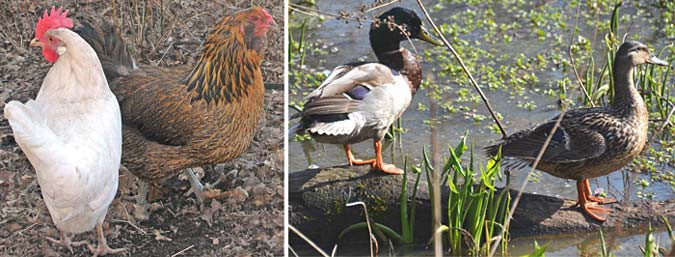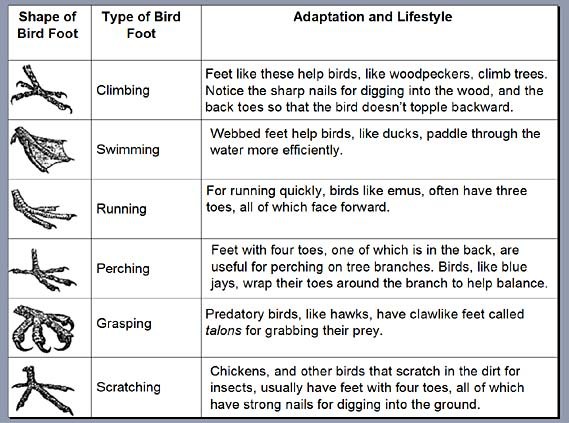Abstract
Animals survive in all sorts of extreme environments, whether it is a polar bear out and about when it is -40°F, a desert iguana trying to find food as the temperature rises to 110°F, or a deep sea anglerfish living 3281 feet down into the sea. How do they do it? The answer is adaptations! Their bodies have special features that allow them to live in those environments. You might not be able to dive down 3281 feet to observe the deep sea anglerfish, but in this science fair project you can discover what the adaptations of birds in your own backyard tell you about their lifestyles.Summary
Sandra Slutz, PhD, Science Buddies
This science fair project was based on a DragonflyTV episode.

Objective
Investigate how well a bird's foot type reflects its lifestyle.
Introduction
If you were an animal with a thick layer of fat under your skin and a heavy coat of fur (like a polar bear) would you live in a tropical forest? No way! You would be way too hot! But if you lived in the cold of the Arctic, near the North Pole, these physical features would be necessary to keep you warm. Physical features that help animals survive in their surroundings are called adaptations. All creatures have adaptations. Some adaptations help animals deal with the climate, like the polar bear example above. Other adaptations help animals move better in their environment, blend in with their surroundings so that they do not get eaten by predators, or help them successfully gather dinner.
Birds are animals with a lot of specific and useful adaptations. One major adaptation is the shape of their feet. Have you ever looked at a bird's feet and noticed how different they are from other types of birds' feet? For example, chickens and ducks are both birds, but they have very differently shaped feet! Chicken feet have long skinny toes with strong, sharp nails to scratch at the ground and find insects and seeds to eat, while ducks have webbed feet to help them paddle in the water, as shown in Figure 1.
 Image Credit: Wikimedia Commons / Creative Commons Attribution-Share Alike 2.5 Generic
Image Credit: Wikimedia Commons / Creative Commons Attribution-Share Alike 2.5 Generic
Figure 1. Chickens and ducks have very different feet, which can help them succeed at their different lifestyles. (Image of ducks from Tony Alter, 2012.)
 Image Credit: Norman Bird Sanctuary / permission via e-mail by Catherine Arning Director of Education at Norman Bird Sanctuary
Image Credit: Norman Bird Sanctuary / permission via e-mail by Catherine Arning Director of Education at Norman Bird SanctuarySix types of birds feet are pictured and described on a chart. The first foot has two toes pointed forward and backward made for climbing and gripping tree branches. The second foot is webbed which helps certain birds move through water. The third foot has three forward facing toes which help with running on land. The fourth foot has three forward facing toes and one backward facing toe to help with balance when resting on branches. The fifth foot has four forward facing toes with large nails that can dig into prey. Finally the sixth foot has three forward facing toes and a small backward facing toe with small nails that help to scratch and dig up soil to find insects underground.
Figure 2. The table above illustrates six different types of birds' feet and how these adaptations help the bird survive (chart adapted from the Norman Bird Sanctuary, 2000).
In this zoology science project, you will investigate how well a bird's foot type reflects its lifestyle, specifically in terms of where it usually spends its time and how it usually gets its food. To conduct your experiment, you will need to find a place where you can observe birds, mark down what type of feet each bird has, predict what kind of lifestyle the birds have based on their foot type, and then do a little research about the birds to see if you were right. Have fun bird watching!
Terms and Concepts
- Adaptation
- Climate
- Environment
- Surroundings
- Predator
- Observe
- Species
- Prey
- Talons
- Forage
- Habitat
Questions
- What kind of habitats can you find birds in?
- What types of food do birds eat? What are some ways they use to get their food?
- What species of birds live in your area?
Bibliography
This science fair project was based on this DragonflyTV episode:
- Twin Cities Public Television, Inc. (2006). California Fish by Milan and Harison. DragonflyTV. Retrieved July 3, 2008.
These websites are good resources for identifying birds and researching their lifestyles:
- Cornell Lab of Ornithology. (2007). All About Birds: Birding Basics. Retrieved July 3, 2008.
- Fernbank Science Center. (n.d.). Bird Feet. Retrieved August 21, 2013.
- Audubon. (n.d.). Guide to North American Birds. Retrieved February 10, 2023.
- Cornell Lab of Ornithology. (n.d.). All About Birds: Search Our Bird Guide. Retrieved August 22, 2013.
For help creating graphs, try this website:
- National Center for Education Statistics, (n.d.). Create a Graph. Retrieved June 25, 2020.
Materials and Equipment
- Places to observe birds; Read the Experimental Procedure for details.
- Binoculars, inexpensive ones are fine; inexpensive 10x magnification and 25 mm objective lens binoculars can be bought at most sporting goods stores or online at Amazon.com.
- Bird field guide or other books about how to identify birds in your area; can be borrowed from local library or purchased at a bookstore. Alternatively, you could use the resources listed in the Bibliography to identify the birds you see and learn more about them.
- Lab notebook
- Graph paper
Experimental Procedure
-
To start this science fair project, you will need to find places where you can observe birds. Here are several suggestions:
- Your backyard, especially if you have a bird feeder or a birdbath there
- A park
- A field
- A forest
- Someplace with water, like a river, pond, lake, or marsh
- The beach
- An aviary at a zoo
- A pet store
- A farm that has different types of birds (such as chickens, ducks, turkeys, etc.)
- Go to one of the bird-observation places you have decided on and observe the birds there. Be sure to have an adult go with you.
-
Identify the different species of birds you see.
- If you are at a zoo, pet store, farm, or other place where the species of birds around you are labeled, this will be easy.
- If you are outdoors, use a field guide with pictures and descriptions of the birds to help you identify what species of birds you see. You could use a field guide book or an online resource, such as the Audobon's field guide for birds. You may want to ask an adult for help looking up the different birds.
- In your lab notebook, make a data table like Table 1, and write down the species of birds you see in your data table.
-
Look at the feet of each species of bird. Write down in your data table which type of feet each species of bird has. Use Figure 2 as a reference for the different types of bird feet.
- You may need to use a pair of binoculars to clearly see the birds' feet.
- If it is difficult to clearly see any bird's feet, you could look for pictures of the bird that more clearly show their feet (such as in a field guide book or in pictures online).
- Make observations for at least 10 species of birds. You may need to go to more than one bird-observation location to collect all your data. Be sure to write your observations down in the data table in your lab notebook.
-
Based on the type of feet each bird has, predict what kind of lifestyle you think that type of bird has. Write down your predictions in the data table in your lab notebook.
- Where does it spend its time? Is it usually perched in a tree, climbing trees, on the ground, or swimming in the water?
- Can you tell how it gets its food? Does it grasp prey (like mice or fish) with its talons, or maybe scratch for insects and worms in the soil? Or maybe it eats seeds while holding onto a branch, or climbs a tree looking for insects in its bark?
-
Research each species of bird to find out where it spends its time and how it gets its food, or forages for food. (Tip: Finding out what the bird eats, such as small animals, insects, or seeds, may help you understand how it gets its food.)
- Books about birds, and bird identification websites, like the ones in the Bibliography in the Introduction, are good sources for researching.
- Record your results in the data table in your lab notebook.
- Note: Birds may spend time in multiple places. For example, a bird might roost (or sleep) while perched in a tree, and build a nest in a tree, but it might also spend some time on the ground. For this science project, focus on where the bird spends most of its time. (But you may make notes in your lab notebook about other places the bird spends time as well.)
- Note: When researching how the bird gets its food, you might find that a bird gets food in several different ways. For this science project, focus on the way the bird usually gets food. (But you may make notes in your lab notebook about the other ways in which the bird gets its food.)
| Species | Type of Feet | Predicted Lifestyle | Researched Lifestyle | ||
| Where does the bird spend its time? | How does the bird get its food? | Where does the bird spend its time? | How does the bird get its food? | ||
-
Make two pie charts representing your data.
- One pie chart should show the percentage of the cases you correctly predicted where the bird spends its time.
- The second pie chart should show the percentage of the cases you correctly predicted how the bird gets its food.
- You can make the pie charts by hand or use a website like Create a Graph to make them on the computer and print them.
- Based on your charts, how accurate an indicator was each bird's foot type for the kind of lifestyle it usually leads? How about as an indicator of how the bird gets its food? Were the foot adaptations better at predicting where the birds spent time, or better at predicting what they ate? Why do you think you got the results that you did?
Ask an Expert
Global Connections
The United Nations Sustainable Development Goals (UNSDGs) are a blueprint to achieve a better and more sustainable future for all.
Variations
- Are bird beaks also adaptations? Do birds with different types of beaks eat different things? Design an experiment to find out.
- Do birds in the same habitat have similar types of feet? How about birds in different habitats? Try picking two diverse habitats, like the beach and a forest.
- Different species of birds have different social habits. Some types of birds live in flocks, while others are loners or live in small family groups. Does the social nature of the birds have anything to do with how many of a certain type of species you see in a habitat? Design an experiment to find out.
Careers
If you like this project, you might enjoy exploring these related careers:









